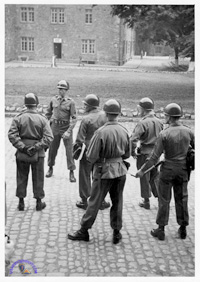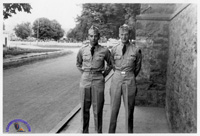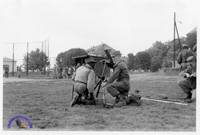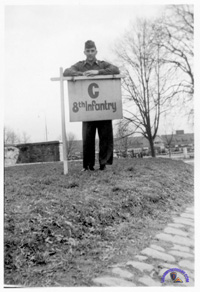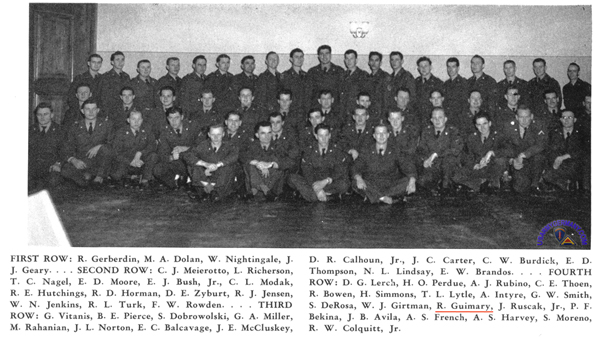| If you do NOT see the Table of Contents frame to the left of this page, then Click here to open 'USArmyGermany' frameset |
|||||||||||||
|
4th
Infantry Division |
|||||||||||||
|
|
|||||||||||||
|
|||||||||||||
|
|
|||||||||||||
| 8th Infantry Regiment | |||||||||||||
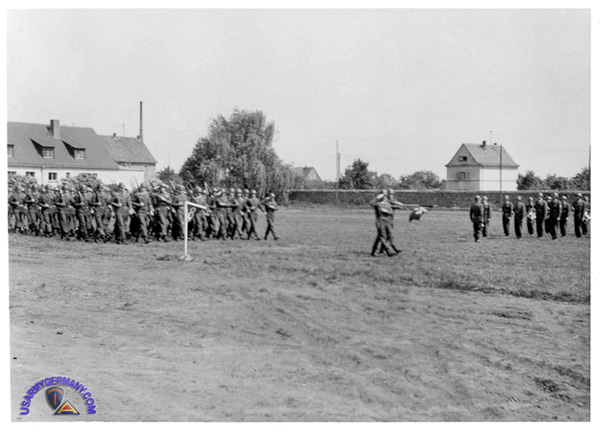 8th Infantry regimental review at Schloss Kaserne, c. 1952 |
|||||||||||||
 8th Infantry Regiment DUI 8th Infantry Regiment DUI |
|||||||||||||
| 1952 | |||||||||||||
| (Source: STARS & STRIPES, Dec 28, 1952) | |||||||||||||
|
|||||||||||||
|
|||||||||||||
| 1955 - 1956 | |||||||||||||
| (Source: Email from Charles Valleau, Co A, 8th Inf Regt, Schloss Kaserne, Butzbach, 1955-56) | |||||||||||||
|
|||||||||||||
|
|
|||||||||||||
| 12th Infantry Regiment | |||||||||||||
 12th Infantry Regiment DUI 12th Infantry Regiment DUI |
|||||||||||||
| 1951 | |||||||||||||
| (Source: Email from Ray Guimary, 2nd Bn, 12th Inf Regt, 1951-52) | |||||||||||||
| I was stationed with 2nd Battalion, 12th Inf at Wildflecken Germany from about August 1951 to around January 1952, at which time the 12th was moved to new barracks in Gelnhausen. We were among the first units of the 4th Division to move to Germany from Ft Benning, where the Division had formed up in early 1951.
I was a Sgt in S-2, of 2nd Battalion Hq, of 12th Infantry Regt, of 4th Division. Since I was in Headquarters, I had pretty good knowledge of what our mission(s) were and what was going on. Some Division History: 4th Infantry Division was reformed at Ft Benning (in a hurry) in early 1951. After advanced Infantry Training, the Division shipped out about May 1951 via NY/NJ to Germany. I think 12th was one of early units. We disembarked at Bremerhaven and moved by train to squad tents in Mannheim. After about a month 2nd Bn was trucked to Mainz, again to squad tents. After about 6 weeks we finally moved to Wildflecken. The barracks at Wildflecken had just been renovated and repainted. We were told Wildflecken was once a Kaserne and training grounds for part of Rommel's Africa Corps. Incidentally, 4th Division was first combat division to post to Germany since end of WWII. (Webmaster note: One division -- the 1st Inf Div -- had remained in Germany after the end of the war as part of the US Occupation Forces.) US Troops were sent to join NATO, to counter Russian threats and maneuvers and to reassure Germans that any moves by Russians would bring us into war. Germans were very, very glad to see us. Parts of Bavaria we travelled hadn't seen U.S. soldiers since WW 2. 1st and 2nd Battalions of 12th Inf were at Wildflecken (don't remember where 3rd Bn was) along with several separate service units….one of which was a company or two of Black soldiers. This was before full integration took place, which happened while we were there and our company received first and only Blacks. 1st & 2nd Bns of the 12th Inf were at Wildflecken for about a year, from June 1951 to about June 1952. We then moved to brand new -- some were barely finished -- barracks at Gelnhausen, which was about 20 miles South of Frankfurt. While at Wildflecken we were equipped with good Winter gear; shoe paks, fur lined jackets, hats. gloves, etc. At Wildflecken we were on constant "ready" status. That is, no more than 1/3rd of the personnel could be absent at any time ( Bn staff included). We had constant alerts, sometimes 2 in a week. On alerts the whole battalion would take to the field to a pre-specified position prepared for an undetermined stay. Sometimes we would be there for an hour, sometimes for 3-4 days. Timing seemed to be a big factor --just how fast we could get out, and how fast we could report in at the new required position. We, 2nd Bn, sometimes Regiment, (sometimes the whole Division), took part in a number of field maneuvers, I remember one time we were part of large NATO exercise. At Wildflecken, part of our S-2 duties was to check out road conditions and general countryside between us and Russian Zone. Up in the mountains, as you might imagine, the Zone border was completely unmarked except for major roads --- which were very few. Border was mostly narrow country roads or other natural landmarks. Brass was very concerned as to whether or not Russians were up there lurking in the woods & mountains. We maintained the same duties, but to a lesser extent, at Gelnhausen. Line companies mostly trained in field exercises. We were very concerned about Russians. As you may remember conditions were tense -- Berlin Blockade/Airlift not long before, and Korean War really escalating. Plus we were very aware of Russian & Eastern countries overwhelming troop numbers. |
|||||||||||||
 Unidentified kaserne - probably Mangin Kaserne (Lee Barracks), Mainz |
|||||||||||||
 Unidentified kaserne - probably Mangin Kaserne (Lee Barracks), Mainz |
|||||||||||||
| (Source: 4th Infantry Division. Occupation of Germany, 1952 Yearbook) | |||||||||||||
| Webmaster note: After reading Ray's email (see above), I did some research in the 1952 Yearbook and found two photos that I am almost certain are Mangin Kaserne (later renamed Lee Barracks) in Mainz. The photos (above) show a tank park, probably of the 12th Infantry Regiment, and a tank retriever at work. The buildings shown in these two pics look identical to some of the buildings at Mangin. This could indicate that the Regiment was temporarily billeted at Mangin after its initial stay at Y-79 (Coleman Barracks) in Mannheim-Sandhofen and before moving to Camp Wildflecken. Can anyone provide additional details on where the various 4th INF DIV elements were temporarily stationed while waiting for their permanent stations to be remodeled? |
|||||||||||||
| 22nd Infantry Regiment | |||||||||||||
|
|||||||||||||
 22nd Infantry Regiment DUI 22nd Infantry Regiment DUI |
|||||||||||||
| Related
Links: |
|||||||||||||



